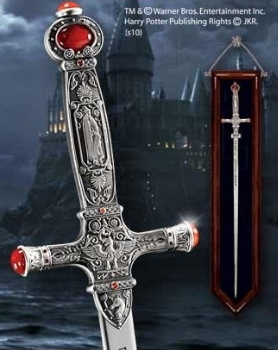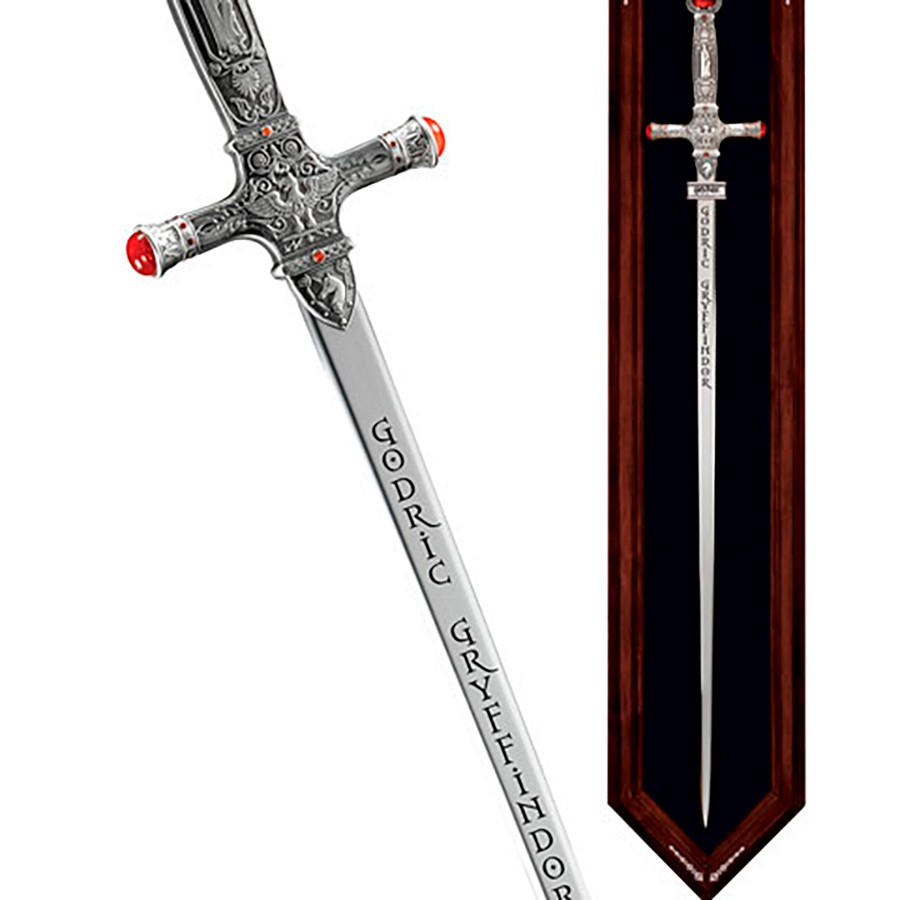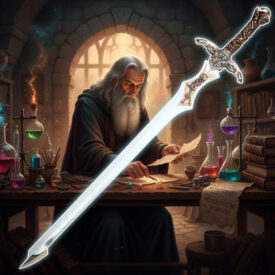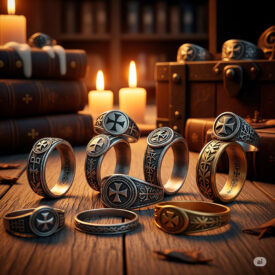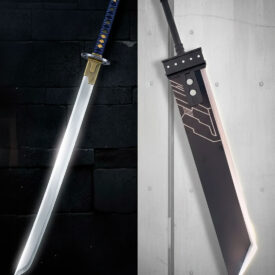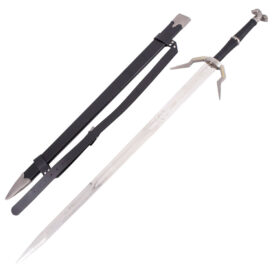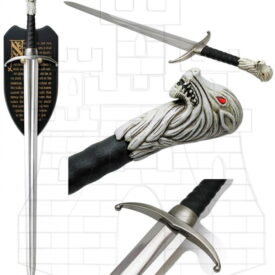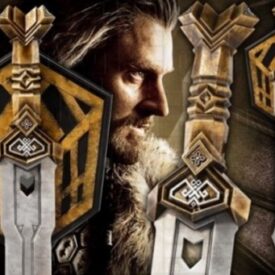Unsheath your curiosity and step into the magical world of Harry Potter’s swords! Beyond wands, these legendary weapons have forged unforgettable moments and have been key in the fight against dark forces. From the iconic Sword of Godric Gryffindor to other notable blades, their presence in the saga is as fascinating as it is crucial. They have witnessed epic battles, saved lives, and symbolized the courage and nobility of their bearers. Exploring the role of these swords is to dive into the very essence of the magic and bravery that define the universe created by J.K. Rowling.
In a world where magic flows through spells and enchantments, the inclusion of physical weapons like swords adds a layer of depth and a touch of ancient tradition. They represent a connection to the past, to the founders of Hogwarts, and to a form of heroism that transcends mere magical skill. Each sword has its own story, its own legacy, and its appearance in the saga is never accidental, always marking a turning point or revealing a hidden truth. They are much more than mere objects; they are extensions of their owners’ will and, in some cases, possess an almost sentient consciousness.
The Sword of Godric Gryffindor: A Relic of History and Magic
The Sword of Godric Gryffindor is no ordinary weapon; it is an emblematic relic of the wizarding world, forged more than a thousand years ago by skilled goblins, considered the best smiths. Its creator was Ragnuk I, the king of the goblins and the most talented silversmith of his time. This sword is a testament to goblin craftsmanship, a unique piece that combines unparalleled beauty with immense power, destined to be a symbol of the house that bears its name and an instrument of justice in the hands of the brave.
Its very existence is a reminder of the ancient days of magic, when the founders of Hogwarts laid the foundations of a complex and wondrous world. The Sword of Gryffindor not only represents the house of the brave but also the intrinsic connection between magic, history, and destiny. Its appearance in moments of dire need underscores its role as an object with a will of its own, able to manifest only to those who show the courage and purity of heart worthy of Godric Gryffindor.
Goblin Origin and Forging: The Mastery of Ragnuk I
The forging of the Sword of Godric Gryffindor is a legend in itself, a tale that speaks of the goblins’ unmatched skill. Ragnuk I, king of the goblins and a silversmith of unrivaled genius, was tasked with creating this masterpiece. Goblins are known for their superior metallurgy; their creations are not only beautiful but also possess inherent magical properties, a quality no other race can replicate. The sword was the result of a specific commission by Godric Gryffindor, who sought a weapon that would reflect the spirit of his house and endure through the ages.
The goblin forging process is a closely guarded secret, passed down from generation to generation. It is said that they infuse magic into the metal from the very moment it is extracted, shaping it with ancient spells and chants. The pure silver used for Gryffindor’s sword is not just a material; it is a conduit for magic, chosen for its resilience and its ability to interact with arcane forces. The rubies set into the hilt are not mere decorations; they are also believed to contribute to its magical properties, channeling the energy and courage of its bearer.
Magical Features and Unique Properties
This magnificent sword is made of pure silver and has rubies set into its hilt, a nod to Gryffindor house colors. The goblin magic that forged it endowed it with astonishing properties: it is indestructible and never loses its edge, nor does it need to be cleaned or polished, as it repels dust and dirt. This self-cleaning quality is a testament to advanced goblin wizardry, which fuses functionality with aesthetics in a way few magical objects can match.
It also has a unique and crucial quality: it absorbs and retains that which makes it stronger. A clear example is Basilisk venom, a substance so potent it can destroy Horcruxes. This absorption property is what makes it such a formidable weapon against dark magic. Not only is it resilient, but it adapts and evolves with every challenge, becoming more powerful with each dangerous encounter. It is a sword that learns, that grows, and that becomes a reflection of the battles it has fought, carrying with it the essence of its victories.
The sword’s indestructibility is not just a physical trait; it is a symbol of the unbreakable resilience of Gryffindor house and the ideals it represents. Its perpetual edge ensures it will always be ready for battle, no matter how much time passes or what circumstances arise. These properties are no accident; they are the result of the goblins’ deep understanding of the magic of materials and the intention behind its creation: a sword that would serve as a beacon of hope and the ultimate weapon for those who fight for what is right.
The Conflict with the Goblins: A Legend of Resentment
Although it was commissioned by Godric Gryffindor, Ragnuk I, its maker, coveted it once finished. The goblin king invented the false claim that Gryffindor had stolen it and sent his minions to retrieve it. This dispute was not only about the possession of an object but about a fundamental difference in philosophy between humans and goblins. For goblins, anything created by their hands remains rightfully theirs, even if they have been paid for it. They consider their art and work an extension of themselves, and payment is only compensation for time and effort, not a transfer of ownership.
Godric, however, defeated them with magic and sent them back with a clear message: if they tried to steal it again, he would draw the sword against them. The goblins took the threat seriously and Godric kept the sword, though Ragnuk’s resentment lasted until his death, giving rise to the legend among goblins that Godric Gryffindor stole the sword from them. This incident reflects the historical tensions between the magical and goblin communities, a cultural rift that has often led to misunderstandings and conflict. The story of Gryffindor’s sword is, therefore, not only the story of a weapon but also of a complex and often contentious relationship between two powerful races of the wizarding world.
This conflict underscores the importance of the sword not only as an object of power but as a symbol of human independence and autonomy in the face of goblin claims. The legend of its “theft” was passed down through generations of goblins, fueling a deep resentment that would manifest centuries later in characters like Griphook. The sword, therefore, carries with it not only the magic of its forging but also the weight of a history of conflict and pride that makes it even more significant in the tapestry of the Harry Potter universe.
The Sword Through Key Moments in the Saga
The Sword of Godric Gryffindor is not just a relic; it is an active character in the saga, appearing at the most crucial moments to change the course of events and reveal the true nature of its bearers. Its appearance is always a harbinger of a great challenge and an opportunity for the purest courage to shine.
The Chamber of Secrets: The Birth of a Hero
Its first appearance in “Harry Potter and the Chamber of Secrets” is unforgettable and defines Harry’s destiny. When Harry was cornered by the Basilisk, a creature with lethal venom and a deadly gaze, Fawkes, Dumbledore’s phoenix, brought him the Sorting Hat. From it, Harry drew the Sword of Gryffindor and used it to defeat the creature, an act of bravery few could have achieved. At that moment, the blade absorbed the Basilisk’s venom, gaining the ability to destroy Horcruxes, a property that would be fundamental in the future.
This event also revealed one of the sword’s most important properties: it only appears to a true Gryffindor, that is, a student of that house who demonstrates great valor and courage. The sword is not simply an object that can be taken; it is an object that chooses its bearer, manifesting only when the need is dire and the Gryffindor’s heart is pure. The sword’s appearance in the Chamber of Secrets not only saved Harry but also marked him as a true heir to Gryffindor’s spirit, a hero worthy of legend.
The Second Wizarding War: A Weapon Against Horcruxes
During the Second Wizarding War, the sword became a vital tool in the fight against Voldemort, as its power to destroy Horcruxes was discovered. After Dumbledore’s death, it was bequeathed to Harry, but the Ministry of Magic, under Voldemort’s control, confiscated it, believing it lost. However, Dumbledore had foreseen this and, together with Severus Snape, planned a replica to deceive Voldemort and hide the real one. This complex strategy demonstrated Dumbledore’s foresight and Snape’s secret loyalty.
Snape, using his Patronus—a silver doe—guided Harry to the sword, which was hidden in a frozen lake. This act by Snape was proof of his enduring love for Lily Potter and his commitment to Dumbledore’s cause. Ron Weasley, demonstrating his own worth and courage, used it to destroy Slytherin’s Locket, one of Voldemort’s Horcruxes. This moment was crucial not only for the destruction of a Horcrux but also for Ron’s growth as a character, solidifying his place as an indispensable member of the golden trio. The Sword of Gryffindor, once again, manifested at the precise moment for the right Gryffindor, guided by destiny and need.
The Climax at the Battle of Hogwarts: Neville’s Worth
Although the sword was stolen by the goblin Griphook during the attack on Gringotts, it reappeared at a crucial moment in the Battle of Hogwarts. Neville Longbottom, a character who had grown in bravery throughout the saga, demonstrating incredible courage and loyalty, drew it from the Sorting Hat. This act was the ultimate proof that Neville was a true Gryffindor, worthy of wielding the legendary weapon.
Neville used it to behead Nagini, the snake and Voldemort’s final Horcrux, thus bringing about the end of the Second Wizarding War. This heroic act not only proved Neville’s worth but was also decisive for Voldemort’s final defeat, as Nagini’s destruction left the Dark Lord vulnerable and mortal. The Sword of Gryffindor, true to its nature, once again manifested for the Gryffindor who needed it most, sealing the fate of the war and ensuring the victory of good over evil. The sword’s story is intrinsically linked to the story of the fight against Voldemort, being a key instrument in every step toward his downfall.
Owners and Their Legacy
Throughout history, several characters have possessed the Sword of Gryffindor, each leaving their mark on its legend and contributing to its mystique. Here are some of its most notable owners:
- Godric Gryffindor: The house founder, its original owner, and the sword’s namesake. He represents courage and nobility.
- Harry Potter: Wielded it in the Chamber of Secrets to defeat the Basilisk, absorbing its venom and gaining the ability to destroy Horcruxes.
- Albus Dumbledore: Kept it in his office and bequeathed it to Harry, demonstrating his trust in the young wizard and his foresight.
- Severus Snape: Although he did not wield it in battle, he was instrumental in guiding Harry to it, revealing his hidden loyalty.
- Ron Weasley: Used it to destroy Slytherin’s Locket, demonstrating his bravery and growth as a Gryffindor.
- Griphook: The goblin who stole it from Bellatrix Lestrange’s vault at Gringotts, motivated by ancient goblin resentment.
- Neville Longbottom: Drew it from the Sorting Hat in the Battle of Hogwarts to destroy Nagini, the final Horcrux, an act of immense valor.
Each of these owners, in their own way, demonstrated the courage and determination that define a true Gryffindor, making the sword not only a weapon but also a symbol of the house and the fight against darkness.
Beyond Gryffindor: Other Notable Swords in the Wizarding World
While the Sword of Gryffindor is the most prominent and central in the narrative of Harry Potter, the vast and rich magical universe created by J.K. Rowling hints at or mentions other important swords, even if their role is less active or more symbolic. These other weapons contribute to the depth of the lore and the sense of a magical history that stretches far beyond the main events of the saga. Their mere existence suggests a past full of duels, heroes, and relics still waiting to be discovered or whose purpose has already been fulfilled in the shadows of magical history.
The presence of these other swords, though fleeting, reminds us that the wizarding world is vast and ancient, full of objects with their own stories that could fill entire volumes. Not all swords are instruments for destroying Horcruxes or house symbols; some are family heirlooms, others are historical artifacts, and all add texture to the tapestry of the Harry Potter universe, inviting us to imagine the battles and heroes who wielded them in the past.
The Sword of Sirius Black: A Family Symbol
Although it does not play an active role in combat like the Sword of Gryffindor, Sirius Black’s sword is mentioned as part of the Black family relics, specifically at Number 12 Grimmauld Place. This sword, hanging on the wall of the Black ancestral home, is a symbol of the long and often dark history of one of the oldest and proudest pure-blood families in the wizarding world. Its presence underscores the family’s martial heritage, though by the time of Harry Potter, that heritage had largely been corrupted by loyalty to the Dark Arts.
Sirius Black’s sword is not a weapon wielded by Harry or his friends, but its existence adds a fascinating detail to the atmosphere of Grimmauld Place, a place steeped in history and the ghosts of the past. It represents the tradition of a family that, despite its deviations, was once a formidable force in the wizarding world. It is a reminder that not all magical swords are destined for great heroic feats; some serve merely as symbols of status, lineage, and a past that refuses to be forgotten.
The Sword of Rowena Ravenclaw: A Mystery Unveiled
The Sword of Rowena Ravenclaw is another relic mentioned in the saga, though its role is much more subtle and its nature is not that of a combat weapon in the traditional sense. This sword is a historical artifact, possibly a symbol of the wisdom and learning associated with Ravenclaw house. Unlike Gryffindor’s sword, which is a weapon of war, Ravenclaw’s may have been a ceremonial object or a symbol of intellectual authority, reflecting the values of its founder.
Its mention, though brief, adds a layer of mystery and depth to the story of Hogwarts’ founders. It invites us to imagine what kinds of artifacts the other founders possessed and how they reflected their own personalities and philosophies. The existence of this sword, even though its use or magical properties are not detailed to the same extent as Gryffindor’s, enriches the universe’s lore, suggesting that there are many more stories and relics waiting to be explored in the vast magical world.
Swords on the Big Screen: From Page to Film
The Harry Potter film adaptations stood out for their faithfulness to the books and meticulous attention to detail, including the depiction of swords. The production invested in creating high-quality swords for action and battle scenes, achieving detailed and authentic replicas that were highly appreciated by fans. From the shine of the silver to the embedded rubies, every aspect of the Sword of Gryffindor was recreated with astonishing precision, allowing viewers to immerse themselves even further in the saga’s magic.
The design of the Sword of Gryffindor in the films became an icon in its own right, instantly recognizable by millions of fans worldwide. The production designers worked closely with blacksmiths and prop experts to ensure the sword not only looked impressive but was also functional for combat scenes. The weight, balance, and shape of the hilt were carefully considered so that the actors could handle it convincingly, adding authenticity to every blow and movement.
In addition to the Sword of Gryffindor, other weapons and magical objects were recreated with the same level of detail, contributing to the films’ visual immersion. The attention to these replicas not only satisfied the expectations of book fans but also elevated the quality of the film production, setting a standard for future fantasy adaptations. The swords on the big screen were not just props; they were extensions of the narrative, visual tools that helped tell the story and convey the emotion of every magical confrontation.
The impact of these cinematic representations has been immense, inspiring legions of fans to seek out their own replicas and immerse themselves in the world of movie prop collecting. The Sword of Gryffindor, in particular, has become an object of desire for collectors and enthusiasts, a testament to the saga’s enduring influence and the meticulous craftsmanship invested in its visual adaptation. The way these swords came to life on the big screen is a brilliant example of how art and craftsmanship can elevate an already magical story to new heights.
Choosing Your Own Legend: Tips for Fans and Collectors
For the millions of Harry Potter fans around the world, the saga’s swords are not just fictional objects; they are symbols of bravery, magic, and adventure. If you’ve ever dreamed of wielding the Sword of Gryffindor or owning a replica of the Black family relics, you’re in the right place. Acquiring a replica of these swords is a tangible way to connect with the wizarding world and bring a piece of its legend into your own home. However, choosing the right replica requires considering several factors, from authenticity to safety and care.
Why a Harry Potter Sword?
The fascination with Harry Potter swords goes beyond their function as weapons. For many, they are collectibles that represent iconic moments from the saga. A fan might want a replica for:
- Collecting: Adding an iconic piece to their Harry Potter collection.
- Display: Decorating their space with a symbol of courage and magic.
- Cosplay: Completing a character costume for events or conventions.
- Gift: Surprising a friend or loved one with a unique and meaningful present.
- Emotional connection: Feeling a deeper bond with the story and characters.
Each sword replica is a reminder of battles fought, sacrifices made, and the triumph of good over evil. Owning one is a way to honor the saga’s legacy and keep the magic alive in everyday life.
Types of Replicas and Materials
The market offers a wide variety of Harry Potter sword replicas, varying in quality, material, and price. It’s essential to know the available options to make an informed decision:
- Metal replicas (functional or decorative): These are the most faithful to the originals in appearance and weight. They can be made of stainless steel or metal alloys. Functional ones are usually sharp and not recommended for display without precautions. Decorative ones, though made of metal, usually have a blunt edge and are designed for display. They are the most expensive and require more care.
- Resin or plastic replicas: These are lighter and more affordable, ideal for cosplay or for children (with supervision if they have pointed details). They offer a good level of visual detail but not the durability or realism of metal.
- Foam or latex replicas: Perfect for live-action role-playing (LARP) or for children, as they are safe and non-damaging. They are the most affordable and least detailed, but serve their recreational purpose.
- Luxury/limited edition replicas: Made with high-quality materials, often with certificates of authenticity and exceptional finishes. These are high-value collector’s items.
The choice of material will depend on your purpose: do you want an impressive display piece, an accessory for your costume, or a safe toy for your children?
Considerations When Buying: Authenticity and Safety
When acquiring a Harry Potter sword, keep the following points in mind:
- Official license: Look for replicas with an official Warner Bros. license. This ensures the product is authentic and meets approved quality and design standards.
- Seller reputation: Buy only from trusted sellers and stores specializing in movie or collectible products. Read reviews from other buyers.
- Materials and finishes: Check the product descriptions. What is it made of? Are the details accurate? Are the finishes high quality (paint, polish, inlays)?
- Safety: If the sword is for a child or for cosplay, make sure it has no sharp edges or parts that can easily come off. Metal replicas, even decorative ones, should be handled with care and kept out of reach of children.
- Price: Replicas vary greatly in price. Set a budget and look for the best option within it, prioritizing quality over low cost if you want a durable piece.
Caring for and Maintaining Your Magical Sword
Once you have your sword, you’ll want to ensure it stays in perfect condition. Although the Sword of Gryffindor needs no cleaning, your replica does:
- Cleaning: For metal replicas, use a soft, dry cloth to remove dust. If necessary, a specific metal cleaner can be used sparingly. For resin or plastic replicas, a damp cloth is sufficient.
- Display: Store the sword in a cool, dry place, away from direct sunlight and humidity, which can damage materials. A wall mount or display case is ideal to protect and proudly exhibit it.
- Handling: Avoid touching the metal blade with bare hands, as skin oils can cause corrosion over time. Wear gloves if you handle it frequently.
- Storage: If you’re not displaying it, keep it in its original packaging or in a protective case to avoid scratches and dust buildup.
Ultimately, swords—especially Godric Gryffindor’s—are much more than simple weapons in the Harry Potter universe; they are symbols of valor, courage, and essential elements that drove the plot and contributed to the lasting legacy of one of the most beloved franchises of all time.
If you’re looking for a high-quality replica to add to your collection or to proudly display, we invite you to explore our selection of HARRY POTTER SWORDS, where you’ll find the perfect piece to forge your own legend.



